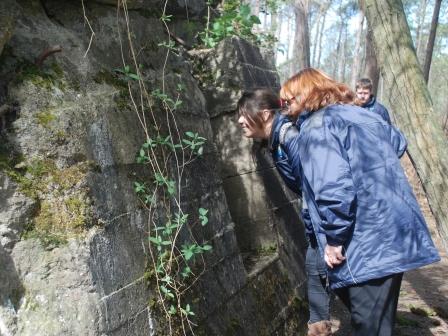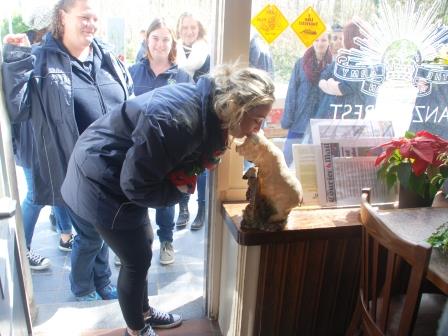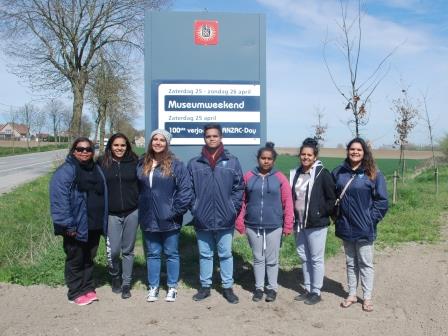April 17th
Day 11 April 17th Ypres Salient –Spanbroekmolen to Polygon Wood. Langemarcke and Essex Farm.
We started our day by driving back to the Messines region to look at the Spanbroekmolen Crater which is one of the 19 mines that was set off on the 7th June 1917 to begin the Battle of Messines. These explosions combined to make the largest explosion set off by man to that date and the shock rattled windows in the Houses of Parliament in London across the English Channel. The crater has since filled with water and has become known as a Peace Pool. The tranquillity of this pool certainly belies the violence with which it was created, and is the setting for part of Julie’s book.
We then drove to Woods Cemetery where Sarah commemorated her Great, Great Grandfather John Fielding. This cemetery is located well away from major roads and towns and takes quite a walk from the back country lane where we parked the bus to get there. It was a peaceful setting and provided a great backdrop for her commemoration.
We then got back on the bus and drove back to Ieper and then out on the Menin Road following the path of the battles of September and October 1917, (The 3rd Battle of Ypres: Passchendaele). We made our way to Polygon Wood where Julie commemorated her Great Uncle Marty, who was the reason that she started her pilgrimages all those years ago which eventually lead to the founding of Connecting Spirits. This is a beautiful cemetery surrounded by Polygon wood and also contains the 5th Divisional Memorial atop the “butte” or shooting range that was used by the Germans as a fortification during the war.
We then walked into the woods a short distance where Tamika commemorated her Great Great Uncle Bernard. As she read the words that her grandmother had emailed to her shortly before the trip, tears welled in her eyes, and in the eyes of those who witnessed it.
We then made our way through the wood looking at the trenches and blockhouses that still remain from all of those years ago. As we made our way out of the wood we came across the inn of our friend Johan Vandewalle. Here we enjoyed a lunch of ham and cheese with salad, and watched a number of videos including one showing him as an “expert’ in tunnelling and trench warfare. While it would have been wonderful to spend the rest of the day watching these and listening to Johan tell of his role in uncovering remains that have been unidentified for almost 100 years, we still had much to do and made our way out and back onto the bus.
We then drove to Tyne Cot, the largest Commonwealth War Cemetery in the world with 13000 burials and a further 33000 names on the walls of the memorial behind it. Here I commemorated Oscar William Wallin, after whom the “Oscar W” paddle steamer is named. His father built it early in the 20th Century naming it after his only son. Oscar went on to join the AIF and was killed in action during the Battle of the Menin Road on the 20th September. We then visited two Australian VC winners buried in this cemetery, Sgt. Lewis McGee and Capt. Clarence Jeffries. Their citations were read out describing the actions that lead them to be granted the highest award for bravery in the commonwealth.
Kiera Walker
While we were at Tyne Cot today, evrything just hit home! I took what Tamika's grandmother said to her about imagining the gravestones as standing soldiers...it seemed so real. It was a beautiful cemetery and the memory will stay with me.
We then walked along the Anzac walk which makes its way from Tyne Cot toward Passchendaele stopping to look at the site of one of Frank Hurley’s famous photos from the war and taking a photo of the Meningie students in front of the field in which we believe Rufus Rigney was wounded and captured by the Germans on the 12th October 1917.
Back on to the bus and down from the ridge to Langemark which is another massive German Cemetery, containing over 40000 remains in a mass grave and another 30000 or so in group burials around the cemetery.
After spending some time looking at names that were often familiar to South Australians, we made our way to Essex Farm, which is the site of the Regimental Aid Post that John McRae was working in when he wrote the famous poem “In Flanders Fields”.
A nice drive home to a lovely meal at the “Captain Cook” restaurant in Ieper finished off the day. Some of us then made our way to look at the Last Post Ceremony to get an idea of what would be required of us the following evening.
Trae Rigney
An emotional day, a long day after all the commemoration, the girls and myself get some sad news about our dearest uncle. It made me realise the friendship and the love we have for each other, the day after I had to commemorate my uncle Rufus at his grave and I was afraid. But the girls strengthened me up and I thank them. Saw the spot my uncle was caught by the German, I closed my eyes and just couldn't imagine what would of happened, no one could.
Julie Keast
Very appropriate saying at bottom of a headstone which sums up a lot of emotion and feelings of those who lost so many of their young men:
'The call was short the shock severe to part with one we loved so dear.'





















